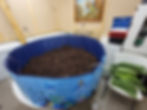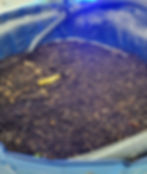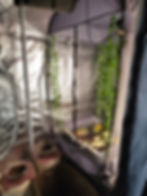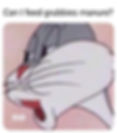Sustainable Chicken Keeping: Raising "Grubbies" to Feed Poultry at Home
- Adrienne Dueringer
- Jan 21, 2023
- 12 min read
Updated: Feb 8, 2023

If you think eggs are expensive now - this is only the beginning. If you are raising laying hens, it is no secret that bag feed ranges from 19-32 dollars a bag, driving homegrown eggs well over the dollar-an-egg mark. With the rising grain cost and egg farms culling birds that test positive for bird flu, prices will continue to soar, causing demand to crash. When demand drops, so will the number of kept commercial laying hens, causing a ripple effect that further delays market recovery. Egg prices may not come down for years as long as global politics have a grip on fertilizer prices or until grain farmers adapt to regenerative farming practices.
As a homesteader, I have been raising poultry for two decades, and until the pandemic of 2020, I could always afford feed for my poultry. The added war in Ukraine created a global grain shortage that made feed expensive, and bulk grain was unavailable in my county and surrounding county co-ops. I knew in 2020 that if I couldn't afford to raise poultry on pasture with the cheapest unprocessed grain possible, the entire food chain would be in short supply.
This made me realize that my homestead wasn't as independent as it needed to be. Although I grew a great deal of fresh organic garden vegetables to raise my poultry all summer, I still depended on the local co-op for the additional feed to provide the nutrients needed. It is impossible to raise poultry without grain to provide enough protein and fiber to keep them full. Chickens that do not have a full crop will eventually start to peck, feather pull, and cannibalize one another as they need a full crop to keep a gizzard working correctly. I had to find another way to supplement their diet to keep them alive, healthy, and in laying condition for those wonderful farm-fresh eggs.
I researched all grains, beans, and legumes I could grow and harvest by hand. Nothing would equal the 12-15% protein needed to raise mature birds and provide the energy required to produce eggs. How could I keep my poultry alive so that I had something to eat? I wasn't about considering the alternative suggested by Bill Gates, the UN, and World Economic Forum to eat bugs. Still, it made me question what was in those recommended bugs they were willing to commercialize for human consumption. What I found was an affordable gold mine in poultry feed that I could grow at home.
Black soldier fly (BSF) grub farms are popping up worldwide. They are being funded by the millions by well-known global organizations as a new alternative to feed humans and livestock due to their excellent protein, vitamin, and mineral bioavailability. Black soldier fly grubs contain 39-48% protein and are full of vitamins and minerals when fed a healthy diet. This means it wouldn't take giant amounts of grubs to provide poultry their 12-15% protein to thrive on pasture with or without grain supplements.
Isn't a fly grub a maggot? Well, technically, yes, but in my mind, a maggot is something that eats trash and rotten, disgusting things. Black soldier fly larvae can be vegetarian-fed and prefer clean, fresh food sources like cucumber, squash, peppers, tomato, and leftover table scraps. I lost the heebie-jeebies quickly when I discovered that they are no more disturbing to handle than earthworms and quite a bit cleaner. They aren't even slimy.
Black Soldier Fly originated in South America but have adapted to live in temperate climate worldwide. In the spring and summer months, they can be lured to lay eggs in pieces of cardboard suspended over sour grain and compost piles. I tried for months to catch some here where I live in Kansas but never had any luck. I had to buckle down quickly because my birds were starving.
Newly hatched black soldier fly larvae (BSFL) can be purchased by mail from several reputable sources. Fly eggs are distributed into bait cups of damp bran and have no problem living through the shipping process. These companies will not ship when the weather does not support it. Once you have purchased larvae, you can choose to grow them out to feed your poultry which would be very costly to continually buy freshly hatched larvae or raise the flies yourself to go full scale. I ordered my fly brood from PopwormsLIVE! Here is the link to their webpage.
(2) PopWormsLIVE!
The worms are very tiny on arrival and, in some cases, may not be visible to the eye as eggs in the shipping media continued to hatch for days. I placed container contents in a bucket with a small amount of fresh, cooked, cooled rice, a little corn flour to keep the moisture content correct, a few slices of cucumber, and a few slices of zucchini. Within a few hours, I would lift the cucumber and zucchini slices to see the tiny grubs chowing down on the slices by the thousands.
The grubs have a generous learning curve and are very forgiving. The substrate needs to be 30-70% moisture. Not too wet and not dry, think potting soil. If the substrate is too wet, they can crawl out of the bin or buckets you raise them in, as the tiny hairs on their body can grip the walls of almost any surface. Using flour on the walls can hinder this if you accidentally get your substrate too wet. Substrates can range from woodchips and sawdust to rice and bran hulls. I use ground whole oats as the drying action works best with high moisture feeds such as cucumber, and as the ground oat grain moistens, they can also consume that. They prefer the same temperature as humans but thrive at 82ºF. Cooler temperatures slow their growth, and the grubs prefer the dark. These grubs grow so fast that there is a daily difference in size. It only takes two weeks to raise a grub to the fatted stage when they are healthiest for serving up as dinner for your livestock.
*NOTE: Digging deep into research for potential health consequences, I learned that fully pupated and dark-colored grubs should NOT be fed to poultry. The grub's outer layer has a high chitin content at this stage. Chitin, also known as chitosan, inhibits fat-soluble vitamin absorption. This will slow the growth of your poultry and create leaner chickens. Laying hens need fat to lay healthy eggs regularly, and lean poultry does not make tender & juicy table fare.
Grubs in the fatted stage are the healthiest for your livestock just before they pupate. Black soldier fly companies are investing large amounts of money in figuring out how to reduce the chitin content so that it may be used for human and other ruminant livestock consumption. These companies also use the harvested chitin to manufacture chitosan for clearing alcohol before distilling and to sell as what I would consider an unhealthy weight loss supplement due to its vitamin-blocking capabilities that starve fat cells.
(3) Effects of dietary chitosan on fat deposition and lipase activity in digestion in broiler chickens
How did I know when the grubs needed more food? They come to the surface and dance in a frenzy. They are not hard to feed. The grubs release a pheromone when they find a good source of food. Other grubs join and create heat, which helps generate more pheromones, and most of the grubs will congregate in "hot spots." To catch the grubs out of the substrate, I use a food such as a pepper, squash, coffee grounds, or piece of meat and lay it on their bedding. The grubs will be teaming under or inside the food in a few hours. I scoop them up or out of the food and place them in a sieve to sort the smaller worms back into a new feed bin to continue to grow out. It didn't take long before I had a system to feed my growing meat chickens 2-6 cups a day. This equates to POUNDS of protein daily!
I watched several hours of YouTube videos before developing the way I thought would suit me best. There are many ways to grow grubs; you can make it as simple or as complicated as you want. There are giant Black Soldier Fly bins for sale for around $700.00, and you can make a bin at home for under $40.00 (PVC and storage bins are expensive). All these options allow the grubs to pupate and crawl from the container in the pupa stage that is high in undesirable amounts of chitin.
I knew I wanted to hatch out the flies, to grow millions of grubs, but I also didn't want to pay a fortune for the available BSF farming kits, so I made my own from affordable items on Amazon.
Here is what I did.

I set up a system in an outbuilding to keep this mess out of the house and to protect it from raccoons. If you overfeed your grubs, they can get pungent. Done correctly; it smells like fresh soil. I knew I would go big with my plan, so I purchased a deep wall kiddie pool and filled it with a few inches of two-year-old wood chips. I tilted the table and added a drain, as well-fed grubs can create a good deal of moisture if the substrate isn't adjusted with dry content to control moisture build-up. That is what the tubing is for. I fed the grubs fresh garden vegetables that I cut in half to make it easier for them to eat. They LOVE Armenian cucumbers, and they are so easy to grow! I no longer use the drain method as I tend to them daily to keep the moisture content correct with finely ground grain. They only require a few cups a week. Looking closely, you can see the pupated grubs in this next photo.

It was amazing how fast they would eat the things I put in the bin, and when they were chewing on food, it was audible when you entered the room. It sounds like bacon sizzling. In three weeks, the grubs pupated, and I thought I would catch the pupated grubs by letting them climb the tubes, as hundreds of YouTube suggested. This method did not work. Most preferred to rest and finish their pupating process right where they were. So I adapted to their likeness. I wanted healthy flies to lay lots more eggs for millions of grubs.

I bought a large mosquito net and covered the pool to let the flies grow out. This time I tried to use the tube to catch the flies to move out of this area into a nicer enclosure to breed. Again, the tube was unsuccessful. These flies are not like house flies. They are slow. You can catch them mid-air and pick them off any surface they land on if some escape. They are drawn to the light, so if some escape, turn off the lights and open the door. They go right outside when shooshed with a broom.
To get them to breed, they need a good light source. I used a high-power grow light to start spring seedlings to mimic their daylight, and I was very successful. Regular daylight is significant, but this building was insulated off at the time to keep the 100º summer heat out and to keep my deep freezers from running so hard. I kept the room around 80ºF as they breed best at 82ºF with 80% humidity.
The flies do not have mouth parts to eat or stingers. However, they require water to drink daily, and I found that the mosquito netting held droplets for them to drink. I placed a bowl of chopped garden veggies in the container to encourage the females to lay eggs, but they would not lay eggs directly on the food. They will only lay eggs in small crevices, and cut up cardboard stacks rubberbanded together is their absolute favorite way to deposit eggs. The females on the cardboard strips wait their turn to lay eggs. Once one female lays, they release a pheromone, and in a few days, the pheromone compounds, and the females will fill hundreds of holes with clutches of eggs anywhere from 500-1,000.

I found the pool and the clothespins too hard to work with, so I bought a pop-up sporting event tent. This is one of those tents used at soccer or baseball games that are big enough to hold a folding chair and a human inside. I got it on sale for $22.00. This was a perfect size, and the ease of the magnetic closure claps allowed me to access my hatching brood. I added the artificial ivy as the males must catch the females in mid-air flight to start the breeding process. As the summer temperatures subsided, I could move the tent in front of a window. The flies would only breed when exposed to some direct sunlight daily. I kept a few small buckets of woodchips, ground grain flour, and summer vegetables in the bin to start the grubs. Things were sailing along smoothly, and I had more grubs hatching than I ever imagined. I was returning the freshly hatched grubs to the pool at the time, but soon I discovered this step wasn't necessary. I just found a better size tub to fit in the sporting tent. I emptied the pool and moved the set up to my spring-sprouting grow tent to start practicing how I would raise them overwinter through freezing temperatures. I knew I needed to have grubs year-round to remain sustainable.

The building I use is insulated and unheated. With the addition of a good quality grow tent and a small $20.00 space heater, this tent maintains 83ºF when temperatures are below zero outside. We had a windchill of -23ºF, and temperatures never dipped inside the tent. I do keep several carboys of water in the tent to use as a heat sink, so the heater does not have to run hard at night.
This is the setup I currently use, and it does all the steps I need. Flies hatch and lay eggs in the sporting tent, and I use homegrown stored winter squash to catch the tiny worms that lodge themselves in the squash within a few hours. Then, I dig them out of the squashes or food source and place them in sieves to let them sort themselves overnight over new buckets of things for them to consume easily. Giant-fatted worms go to the chickens. Small ones crawl down through the sieve and fatten up later. You would not believe these grubs can eat buckets full of nothing but habaneros, scotch bonnets, and chilies. They turn red from the amount of pigment in the peppers and can make the air pungent from the capsaicin released into the air. I was using what I had overflowing from the fall garden harvest. It's impressive that these grubs can make so much protein from vegetables. At times my bins were so full the number of grubs seemed never-ending. Just remember - the females won't lay without the cardboard stacks for their eggs!

Weak constitution? Skip the video. It has grubs in it.
I dump the buckets into the larger bin for one more final sort as they get closer to full size, and from there, the bin is finished out and taken to the chickens or frozen in ziplock bags for future use. The work isn't hard, and the mess isn't nasty once you figure out what you are doing with bin management. It does take a little dedication, but skipping a day or two is not a problem if you can't get to the chore.
I still have a few modifications to make. I need bigger sieves and would like to erect an outdoor facility for summer brooding when laying hens require the most energy. I plan to eliminate grain if I can provide enough garden vegetables and grubs in the summer. This would save hundreds of dollars a year.
Questions I wondered about this process -
~ Did the grubs make the meat or eggs taste funny?
No. Not at all. Poultry that consumes enough protein eats less poop. Poultry will dig through the poop of other animals and their own, looking for, well... grubs! Feces in the gut create microbes that taint meat and give it a gamey flavor.
~ Can grubs eat their way out of a chicken if they eat too many?
No. The grubs devour vegetables, but many must localize and work together on an area to eat meat.
~ Can I feed the grubs meat and fat?
Yes and no. Some meat sources can boost their protein content, but they digest it slower, and it tends to rot in large amounts and it will stink. I found some hog trotters that got freezer burnt from a vacuum bag punctured in the freezer and fed it to the worms. It took them days to eat it, and they never really finished digesting the skin.
Research states that rabbit entrails can promote the gut bacteria in the grubs and in the poultry that consume them.
~ Can I feed the grubs road-kill?
Black Soldier grubs can carry pathogens if fed contaminated animals. You do not need to worry about this if you only provide your grubs with clean food. I do not feed my grubs anything I would not eat.
~ Can I feed them junk food?
Yes. Your livestock is a future extension of your health. They will eat anything you can eat in moderation, but your chickens will only be as healthy as the food you feed them. Treat them and feed them respectfully.
~ Can they eat hay or grass?
No. They can not digest woody organic matter, but if chopped dry and fine, they can be used as bedding in small amounts.
~ Can I feed them manure?

When it comes to mental health, don't do this to yourself. Unless you are starving, you are worth more than growing feed for your poultry from trash and poop. Feeling good about the quality of feed and the animals you raise on that feed keeps you whole as a person. The idea of raising better quality foods at home is what drives us to grow farm-fresh eggs. Don't literally turd yourself out. Your chores remain in your mind and define your farm. Keep them clean.
I hope this gives you some ideas about how to start your own Black Soldier Fly project to keep your poultry happy, healthy, and on your property. Raising and maintaining poultry takes power away from the oligarchs that grip your food supply.
Please share this! And share grubs so others can start their way to self-sustainability and lots of delicious farm-fresh eggs!
To enjoy more sustainable homesteading content, visit growingbacktotheland.com for ad-free blogs and more!

Feeling lost and broken? Find inspiration and hope in 'Growing Back to the Land,' the powerful story of one person's journey back to nature and self-sufficiency. Discover the healing ability of homesteading and the joys of living off the food grid.
Available for free on Amazon Unlimited.
Get your paperback or Kindle copy HERE!



